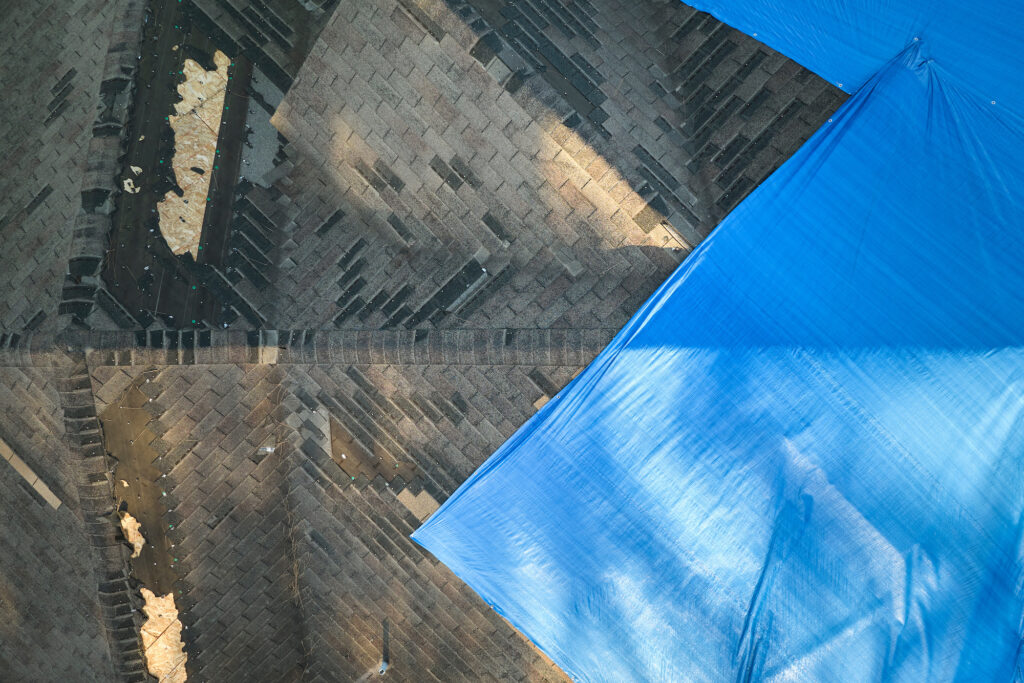Roof damage can strike when you least expect it, leaving your home vulnerable to the elements. Whether it’s a tree branch crashing through during a storm or a sudden leak, emergency roof repairs are critical for protecting your home and maintaining its structural integrity. In this blog post, we’ll break down the entire process of emergency roof repair so that homeowners can be prepared and informed when disaster strikes, including:
- Why Emergency Roof Repair is Crucial
- Immediate Steps to Take When Roof Damage Occurs
- Emergency Roof Repair Process Explained in 6 Steps
- Materials Used in Emergency Roof Repair
- Preventative Measures for Future Roof Damage
🤔 Why Emergency Roof Repair is Crucial
When your roof is compromised, your home is at risk. Water intrusion can lead to interior damage, mold growth, and even structural issues. That’s why addressing roof damage immediately is essential to minimize further complications and expenses. Prompt action can save you from extensive repairs down the line and ensure your family’s safety.
Common Causes of Roof Damage
Several factors can cause emergency roof damage. Severe weather conditions, such as heavy rain, hail, and high winds, are often culprits. Fallen tree branches and debris can also cause significant harm. Additionally, aging roofing materials might give way unexpectedly, leading to leaks and other issues. Understanding these causes can help you take preventive measures.
Spotting Signs of Roof Damage
Being able to identify signs of roof damage early can make a significant difference. Look for:
- Water stains on your ceilings
- Missing or damaged shingles
- Sagging roof sections
If you notice any of these indicators, it’s crucial to act quickly. Ignoring these signs can lead to more extensive and costly repairs.
🚨 Immediate Steps to Take When Roof Damage Occurs
Upon discovering roof damage, there are immediate actions you can take to mitigate the situation. First, ensure the safety of your family by moving them away from the affected area. Next, cover any exposed areas with a tarp to prevent further water intrusion. Document the damage with photos for insurance purposes and contact your insurance provider to start the claims process.
Assessing the Damage
Once you’ve taken initial steps, it’s time to assess the extent of the damage. This often involves climbing up to the roof to inspect for visible issues. However, safety is paramount—if you’re not comfortable doing this yourself, it’s best to wait for a professional. Identifying the problem areas will help you communicate effectively with your roofer.
Temporary Fixes Before Professional Help Arrives
In some cases, you may need temporary fixes to prevent further damage before professional help can arrive. Here are a few DIY solutions:
- Tarping: Secure a tarp over the damaged area to prevent water from entering.
- Sealants: Use roofing sealant to temporarily patch small leaks or cracks.
- Replacing Shingles: If a few shingles are missing, you can replace them with spare ones until a professional repair is done.
These temporary measures can buy you time and reduce the risk of additional damage.
Calling a Professional Roofer
When it comes to emergency roof repair, professional expertise is invaluable. Search for a reputable roofing contractor with experience in handling emergency situations. Look for reviews and testimonials, and ensure they are licensed and insured. Reach out to them immediately to schedule an emergency visit.

🛠️ Emergency Roof Repair Process Explained in 6 Steps
Understanding the step-by-step process of emergency roof repair can lessen the stress and uncertainty you might feel during a crisis. Here’s a detailed look at each stage of the process to help you know what to expect.
1. Initial Assessment
Upon arrival, the roofing contractor will conduct a thorough assessment of the damage. This includes both exterior and interior inspections to identify all affected areas. The contractor will look for visible signs of damage like missing shingles, cracks, or leaks inside the home. They may also check for structural issues and potential hazards that could worsen the situation. This comprehensive assessment is critical as it lays the groundwork for the subsequent repair steps.
2. Temporary Solutions
If immediate action is needed, the roofer will implement temporary solutions to prevent further damage. This could involve tarping the roof to cover any holes and using sealants to stop leaks. The goal is to minimize water intrusion and protect your home’s interior from additional harm while a more permanent solution is prepared. Temporary fixes are not just about preventing water damage; they also help to stabilize the roof until repairs can be made, ensuring that the situation does not escalate.
3. Detailed Inspection
Once the situation is under control, the roofer will perform a more detailed inspection. This helps in determining the full scope of the repair work needed. During this phase, the contractor may use specialized tools to assess hidden damages, such as infrared cameras to find moisture trapped beneath the roof surface. This detailed evaluation is key to creating an accurate repair plan, as it ensures that all issues, not just the obvious ones, are addressed.
4. Repair Plan and Estimate
The roofer will then provide you with a repair plan and a detailed estimate of costs involved. This plan should outline the specific repairs needed, the materials required, and the timeline for completion. Transparency in this stage is crucial for avoiding unexpected expenses. It’s important for homeowners to discuss any concerns or budget constraints at this point. A good contractor will work with you to find solutions that fit your needs while ensuring quality repairs.
5. Execution of Repairs
The actual repair work begins once the plan is agreed upon. Skilled technicians will replace damaged materials, fix leaks, and restore the roof’s integrity. During this phase, you may see the removal of old, compromised shingles, installation of new underlayment, and sealing of any vulnerable areas. Quality workmanship ensures the longevity of the repairs and helps to prevent future issues. The crew should adhere to safety protocols and ensure that the work area remains clean and organized throughout the process.
6. Final Inspection
After repairs are completed, a final inspection is conducted to ensure everything is in order. This also gives you a chance to ask any questions and address concerns. The contractor will check that all repairs meet safety standards and manufacturer recommendations. A thorough final inspection should reassure you that the work has been done properly and that your roof is now well-equipped to withstand future weather challenges. It’s also an opportunity to discuss any maintenance tips to prolong the lifespan of your newly repaired roof.
👉 Materials Used in Emergency Roof Repair
The materials used in emergency roof repair are crucial for ensuring a durable fix. Common materials include asphalt shingles, which offer excellent waterproofing; roofing tar, known for its sealing properties; plywood, providing structural support; and roofing nails, essential for securing everything in place. Using high-quality materials is vital, as they are designed to withstand harsh weather events, ensuring long-lasting protection from leaks and damage.
Cost Factors in Emergency Roof Repair
The cost of emergency roof repair can vary widely based on several factors. The extent of the damage greatly influences the price; more significant damage requires more materials and labor. The types of materials chosen—ranging from basic to premium options—and labor costs, which can fluctuate based on local wages and demand, also play important roles. It’s crucial to budget for these emergencies, as ignoring roof issues can lead to more severe problems and higher costs down the line. Additionally, reviewing your insurance policy is wise, as many policies might cover some or all expenses related to emergency repairs, alleviating some financial burden.
🛑 Preventative Measures for Future Roof Damage
Prevention is always better than cure. Regular roof maintenance is key to avoiding emergency situations and costly repairs. Schedule annual inspections with professionals who can spot potential issues early, keep your gutters clean to prevent water buildup, and trim overhanging tree branches that could damage your roof during storms. Additionally, consider applying protective coatings that can enhance durability and resist weather damage. Investing in these preventative measures not only extends the life of your roof but also saves you money in the long run by reducing the likelihood of major repairs. Take a proactive approach to roof care and protect your home for years to come!
🙌 Emergency Roof Repair Services You Can Trust
For emergency roof repair, having a reliable and experienced team by your side is essential. At Lions Siding and Roofing Experts, we pride ourselves on our commitment to quality, transparency, and customer satisfaction. Our team has the skills and expertise necessary to handle any roofing emergency, ensuring your home is protected and your peace of mind restored. Don’t wait until a small issue becomes a significant problem—trust us to respond swiftly and effectively. Contact us today for a free estimate, and let us safeguard your home with our trusted roofing solutions!

